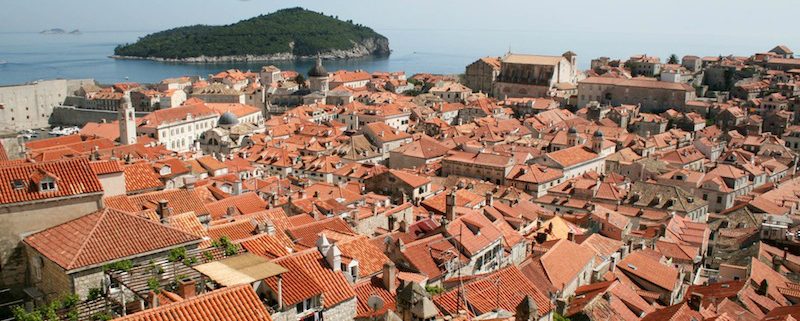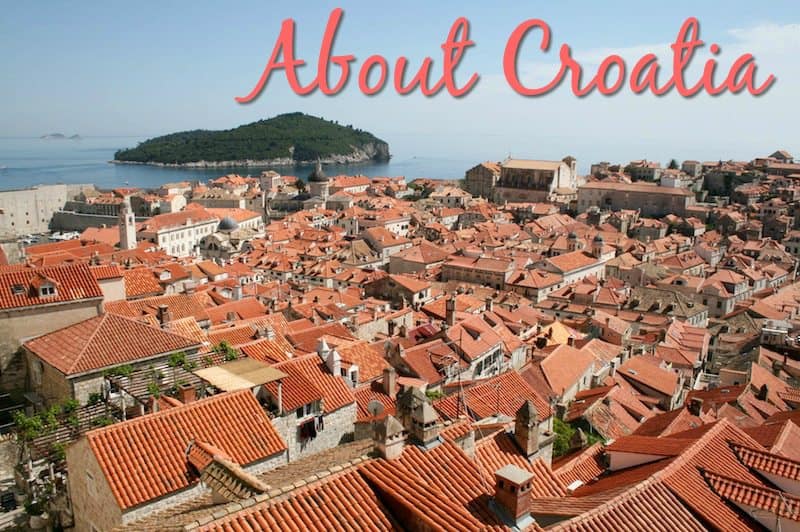
Where is Croatia?
Croatia is a Central European and Mediterranean country, bordering Slovenia to the west, Hungary to the north, Serbia to the east and Bosnia and Herzegovina to the south; the country also has a long maritime border with Italy in the Adriatic Sea. These borders total 2,028 km altogether.
Croatia has an unusual shape (similar to a croissant!) that is unlike any other country in the world. This unusual shape is as a result of five centuries of expansion by the Ottoman (Turkish) empire towards Central Europe. (Although having said this, the Turks never actually conquered the country; they did however control some of Croatia’s neighbours such as Serbia and Bosnia and Hercegovina.) If you’re interested, we have more on Croatia’s past on our history of Croatia page.
Croatia covers a land area of 56,691 square kilometres and has a population of 3.88 million people (2021 census – quite a fall from 4.29 million people recorded in the 2011 census). Almost 90% of the population is Croat (the majority of whom are Roman Catholics) and there are also Serbian, Bosnian, Hungarian and Italian minorities.
Main towns and cities in Croatia
The main population centres are Zagreb, the capital (with a population of about 770,000), Osijek in the northeast (population: 97,000), and the ports of Rijeka (population: 108,000) on the northern part of the coastline, and Split (population: 160,000) towards the south. Other well-known towns and cities include Dubrovnik, Makarska, Porec, Rovinj, Opatija, Zadar and Sibenik.
Croatia has an amazing 5,835km of coastline, 4,057km of which belongs to islands, cliffs and reefs. There are 1,244 islands and islets in the Adriatic, although only about 50 are populated. The largest island is Krk (near Rijeka) which has a land area of 462 square km, whilst other famous islands include Hvar, Brac, Korcula and Pag.

Croatian language
Croatian is the official language, which is written in the Latin script. The Croatian alphabet has 30 letters – all the letters of the English language, minus the q, w, x, and y but with the addition of č, ć, dž, đ, lj, nj, š and ž. See our Croatian for Travellers section for a more detailed guide and an introduction to the Croatian language!
Climate and Weather
The climate is Mediterranean along the Adriatic coast, meaning warm dry summers and mild winters, with 2,600 hours of sunlight on average yearly – it is one of the sunniest coastlines in Europe! The interior of the country has a continental climate with hot summers and cold, snowy winters.
To learn more about Croatia, take a look at:
- History of Croatia
History of this part of Europe and of the Croatian people - Croatia Today
The political situation in present-day Croatia - Croatian Flag & Anthem
See and listen to the national flag and anthem of Croatia - Top Souvenirs from Croatia
Find out what typically Croatian products to buy to take home for yourself or to give as gifts - Famous Symbols of Croatia
Learn about some of the things that Croatia is famous for, including the cravat, Maraschino liquer and the Dalmatian dog - 15 Things You May Not Know About Croatia
A humorous look at some famous and not-so-famous things about the country - Croatian Sports Teams & People
Including Croatian football, tennis and skiing - Famous Croats
Other famous people from Croatia (or of Croatian descent), including those from science, literature, entertainment and other fields - Croatia at the Eurovision Song Contest
Find out how Croatia has fared over the years in the best song contest of all time - Filming Locations in Croatia
Find out where famous big and small screen productions – including Game of Thrones and Star Wars – were filmed in Croatia - Croatian Cuisine
Learn what dishes can be commonly found in the country - What Other People Say About Croatia
Read some articles on Croatia through the years to find out more about the country
Top Facts
- Population 3.8 million (2021 census)
- Capital Zagreb
- Other main cities (by population) Split, Rijeka, Osijek
- Language Croatian, using the Latin alphabet
- Currency Euro (as of 1 January 2023)
- Area 56,691 square kilometres
- Main religion Roman Catholic
- Main ethnic group Croatian (almost 90% of the population is Croatian)
More facts and figures on the country can be found at the CIA World Factbook.
